Decision Making & Learning for Robotics
Past Projects
The
main thrust of my research is the development of decision
making and learning techniques for systems of mobile robotic sensors. At the core of
robotics is the optimization of physical
plans for tasks such as grasping and navigation. In contrast, a
pervasive notion in engineering and computer science is the idea of information
optimization. In my
research, I seek to unify information optimization and physical motion planning to bridge the gap between the near-optimal performance
possible in the digital world and the limited performance currently
possible in the physical world.
My goal is to develop robotic decision making techniques grounded in principled theoretical analysis capable of operating in changing and unstructured environments with imperfect information. I employ formal methods from machine learning, combinatorial optimization, approximation algorithms, and information theory to analyze the hardness of problems and derive techniques with guarantees on performance. Such techniques must be scalable, distributed, and adaptive for operation in the physical world.
My goal is to develop robotic decision making techniques grounded in principled theoretical analysis capable of operating in changing and unstructured environments with imperfect information. I employ formal methods from machine learning, combinatorial optimization, approximation algorithms, and information theory to analyze the hardness of problems and derive techniques with guarantees on performance. Such techniques must be scalable, distributed, and adaptive for operation in the physical world.
|
Machine Learning for Robotic Environmental Monitoring
An important problem for environmental science, biology, and climatology is the prediction of ocean processes based on historical data and ocean models. Available predictive models provide accurate prediction of ocean processes, but they typically do not provide confidence estimates of these predictions. We propose prediction methods based on Gaussian Process (GP) regression, which provide improved estimates of ocean currents and also have the potential to provide confidence bounds on these estimates. We demonstrate experimental validation on ocean current estimates from the Southern California Bight provided by the Regional Ocean Modeling System (ROMS) dataset, and we integrate these predictions into probabilistic planners to improve the safety of operation of autonomous underwater vehicles. Our techniques show potential for significantly improving the prediction of ocean processes for environmental monitoring applications.
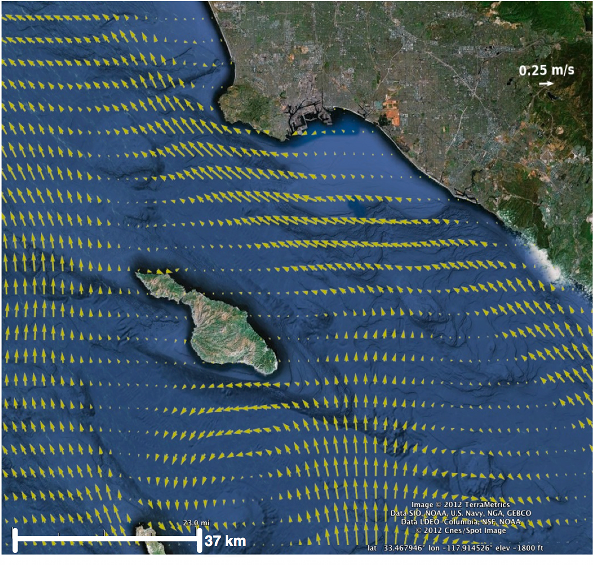  Images: Ocean currents in the Southern California Bight predicted using non-parametric Bayesian regression (left). A risk map that shows predicted shipping lanes that should be avoided to improve the safety of mobile robots operating in the open ocean (right). Publications:
G. Hollinger, A. Pereira, and G. Sukhatme, "Learning uncertainty models for reliable operation of autonomous underwater vehicles,"
in Proc. International
Conference on Robotics and Automation
(ICRA), accepted for publication.
G. Hollinger, A. Pereira, V. Ortenzi, and G. Sukhatme, "Towards improved prediction of ocean processes using statistical machine learning," Proc. Robotics: Science and Systems Workshop on Robotics for Environmental Monitoring (RSS), Sydney, Australia, July 2012. |
|
Autonomous Inspection and 3D Structure Mapping
I am interested in improving inspection of structures and aging
facilities through
informed
planning methods. I
have examined this general problem in the domain of underwater
inspection of a
submerged ship hull with an autonomous underwater vehicle (AUV). The
goal is to construct an accurate 3D model of the structure in order to
detect any anomalies or deformations. My research focuses on the active
setting, where the vehicle selects a path of viewing locations to
improve a metric of inspection performance.
My work formulates the inspection planning problem as an extension to Bayesian active learning, and I showed connections to recent theoretical guarantees in this area. I rigorously analyzed the benefit of adaptivity for such problems, and I proved that the potential benefit of adaptivity can be reduced from exponential to a constant factor by changing the problem from cost minimization with a constraint on information gain to variance reduction with a constraint on cost. Such analysis allows the use of robust, non-adaptive algorithms that perform competitively with adaptive algorithms. Based on the analysis, I proposed a method for constructing 3D meshes from sonar-derived point clouds, and I introduced uncertainty modeling through non-parametric Bayesian regression. Finally, I demonstrated the benefit of active inspection planning using sonar data from ship hull inspections with the Bluefin-MIT Hovering AUV. 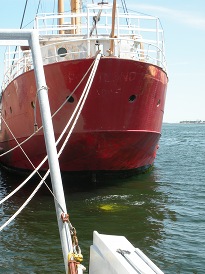 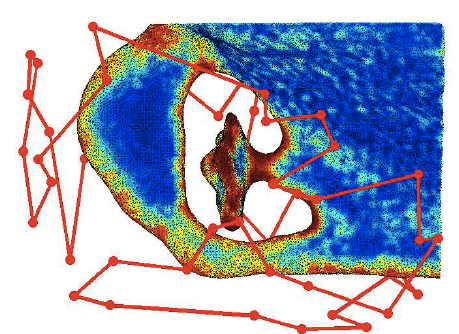 Images: Hovering Autonomous Underwater Vehicle (HAUV) performing an inspection of a submerged ship hull (left). Mesh reconstruction of the ship hull along with the planned path for the HAUV; red areas are areas of high uncertainty that require additional inspection (right). Publications:
G.
Hollinger, B. Englot, F. Hover, U. Mitra, and G. Sukhatme, "Active planning for underwater inspection and the benefit of adaptivity," International Journal of Robotics Research (IJRR), vol. 32, no. 1, pp. 3-18, Jan. 2013.
G. Hollinger, U. Mitra, and G. Sukhatme, "Active and adaptive dive planning for dense bathymetric mapping," in Proc. International Conference on Experimental Robotics (ISER), Quebec City, Canada, June 2012. G. Hollinger, B. Englot, F. Hover, U. Mitra, and G. Sukhatme, "Uncertainty-driven view planning for underwater inspection," in Proc. IEEE International Conference on Robotics and Automation (ICRA), Minneapolis, MN, May 2012, pp. 4884-4891. G. Hollinger, U. Mitra, and G. Sukhatme, "Active classification: Theory and application to underwater inspection," in Proc. International Symposium on Robotics Research (ISRR), Flagstaff, AZ, Aug. 2011. G. Hollinger, B. Englot, U. Mitra, G. Sukhatme, and F. Hover, "Path and view planning for underwater surface inspection," in Proc. Robotics: Science and Systems Marine Robotics Workshop (RSS), Los Angeles, CA, June 2011. |
|
Communication-aware Planning and Coordination
Another important research
thread related to robotic infomration gathering is the
development of planning methods that properly utilize communication
models to improve data collection in mobile networked systems. Along
these lines, I have
examined the problem of utilizing an autonomous underwater vehicle
(AUV) to collect data from an underwater sensor network. The sensors in
the network are equipped with acoustic modems that provide noisy,
range-limited communication. The AUV must plan a path that maximizes
the information collected while minimizing travel time or fuel
expenditure.
My research has proposed AUV path planning methods that extend algorithms for variants of the Traveling Salesperson Problem (TSP). While executing a path, the AUV can improve performance by communicating with multiple nodes in the network at once. Such multinode communication requires a scheduling protocol that is robust to channel variations and interference. To this end, I examined two multiple access protocols for the underwater data collection scenario, one based on deterministic access and another based on random access. I compared the proposed algorithms to baseline strategies through simulated experiments that utilize models derived from experimental test data. The results demonstrate that properly designed communication models and scheduling protocols are essential for choosing the appropriate path planning algorithms for data collection.  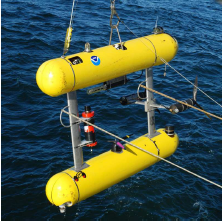 Images: Pictorial representation of a network of underwater gliders in the open ocean (left). A SeaBed class AUV being deployed to perform underwater data collection (right). Publications:
G. Hollinger, S. Choudhary, P.
Qarabaqi, C. Murphy, U. Mitra, G. Sukhatme, M. Stojanovic, H. Singh,
and F. Hover, "Underwater data collection using robotic sensor networks," IEEE Journal on Selected Areas in Communications
(JSAC), vol. 30, no. 5, pp. 899-911, June 2012.
G. Hollinger and S. Singh, "Multirobot coordination with periodic connectivity: Theory and experiments," IEEE Transactions on Robotics (T-RO), 2012, doi:10.1109/TRO.2012.2190178. G. Hollinger, U. Mitra, and G. Sukhatme, "Autonomous data collection from underwater sensor networks using acoustic communication," in Proc. IEEE/RSJ International Conference on Intelligent Robots and Systems (IROS), San Francisco, CA, Sept. 2011, pp. 3564-3570. Video. G. Hollinger, S. Choudhary, P. Qarabaqi, C. Murphy, U. Mitra, G. Sukhatme, M. Stojanovic, H. Singh, and F. Hover, "Communication Protocols for Underwater Data Collection using a Robotic Sensor Network," in Proc. International Workshop on Wireless Networking for Unmanned Autonomous Vehicles (Wi-UAV), Houston, TX, Dec. 2011. G. Hollinger, S. Yerramalli, S. Singh, U. Mitra, and G. Sukhatme, "Distributed coordination and data fusion for underwater search," in Proc. IEEE International Conference on Robotics and Automation (ICRA), Shanghai, China, May 2011, pp. 349-355. Finalist for KUKA Service Robotics Best Paper Award. G. Hollinger and S. Singh, "Multi-robot coordination with periodic connectivity," in Proc. IEEE International Conference on Robotics and Automation (ICRA), Anchorage, AK, May 2010, pp. 4457-4462. Video. |
Past Projects
|
Multi-robot Search in the Physical World
My doctoral thesis examined the broad problem domain of search in the
physical world, which differs
significantly from the searches in the digital world that we perform
every day on our computers. When searching the internet, for instance,
success is a matter of informed indexing that allows the information to
be retrieved quickly. In these cases, there is no consideration of the
physical nature of the world, and the search is not cognizant of space,
time, or traversal distance. In contrast, search in the physical world
must consider a target that could be continuously moving, possibly even
trying to evade being found. The environment may be partially known,
and the search proceeds with information gathered during the search
itself. In many cases, such as guaranteeing capture of an adversarial
target, the problem cannot be solved with a single searcher, and all
group members must coordinate their actions with others on the team.
Prior work had explored limited instances of such problems, but
existing techniques either scaled poorly or did not have performance
guarantees.
I considered two of the main variations of search in the physical world: efficient search and guaranteed search. During efficient search, robots move to optimize the average-case performance of the search given a model of the target’s motion. During guaranteed search, robots coordinate to minimize the worst-case search time if the target is adversarial. My thesis unified these search problems and showed them to be NP-hard, which suggests that a scalable and optimal algorithm is unlikely. In addition, I showed that efficient search admits a bounded approximation, and guaranteed search does not. Despite these hardness results, algorithms using implicit coordination can provide scalable and high-performing solutions to many real-world search problems. Implicit coordination is defined as the sharing of locations, measurements, and/or actions to improve the team plan. In accord with this design strategy, I presented a linearly scalable efficient search algorithm that utilizes implicit coordination to achieve bounded performance. In addition, I contributed a novel approach that augments the coordination with a pre-search spanning tree generation step, which leads to an anytime algorithm for guaranteed search. With a focus on decentralized and online operation, I extended the proposed search algorithms to take into account team constraints, limited communication, and partially known environments. The techniques were illustrated using a scenario from the literature that incorporates both efficient and guaranteed search, and they were validated both in simulation and on human-robot search teams operating in the physical world. The developed framework enables teams of autonomous agents to search environments outside the scope of previous techniques, and the analysis provides insight into the complexity of multi-robot coordination problems.   Images: Autonomous ground vehicles searching an outdoor urban environment for a mobile intruder (left). Maps of an office and museum used for adversarial search; the spanning tree representation guides robotic searchers to guarantee capture of any target in the building (right). Publications: G. Hollinger,
"Search in the
physical world,"
Ph.D. dissertation, Robotics Institute, Carnegie Mellon University,
Pittsburgh, PA, July 2010. Defense
slides, Video
of defense (60 MB).
T. Chung, G. Hollinger, and V. Isler, "Search and pursuit-evasion in mobile robotics: A survey," Autonomous Robots (AURO), vol. 31, no. 4, pp. 299-316, Nov. 2011. G. Hollinger and S. Singh, "Towards experimental analysis of challenge scenarios in robotics," in Proc. International Symposium on Experimental Robotics (ISER), Delhi, India, Dec. 2010. Videos. G. Hollinger, A. Kehagias, and S. Singh, "Improving the efficiency of clearing with multi-agent teams," International Journal of Robotics Research (IJRR), vol. 29, no. 8, pp. 1088-1105, July 2010. Video 1, Video 2. G. Hollinger, A. Kehagias, and S. Singh, "GSST: Anytime guaranteed search," Autonomous Robots (AURO), vol. 29, no. 1, pp. 99-118, July 2010. Video 1, Video 2. A. Kehagias, G. Hollinger, and S. Singh, "A graph search algorithm for indoor pursuit/evasion," Mathematical and Computer Modeling, vol. 50, no. 9-10, pp. 1305-1317, Nov. 2009. G. Hollinger, A. Kehagias, and S. Singh, "Efficient, guaranteed search with multi-agent teams," in Proc. Robotics: Science and Systems Conference (RSS), Seattle, WA, June 2009. Video 1, Video 2. G. Hollinger, S. Singh, J. Djugash, and A. Kehagias, "Efficient multi-robot search for a moving target," International Journal of Robotics Research (IJRR), vol. 28, no. 2, pp. 201-219, Feb. 2009. Video 1, Video 2. G. Hollinger, and S. Singh, "Proofs and experiments in scalable, near-optimal search by multiple robots," in Proc. Robotics: Science and Systems Conference (RSS), Zurich, Switzerland, June 2008. Finalist for Best Student Paper Award. Video. G. Hollinger, A. Kehagias, and S. Singh, "Probabilistic strategies for pursuit in cluttered environments with multiple robots," in Proc. IEEE International Conference on Robotics and Automation (ICRA), Rome, Italy, Apr. 2007, pp. 3870-3876. Video. |
|
EMBER:
Robotics in
Emergency Response The
goal of this project was to
assist first responders in emergency situations by providing tracking
information and situational awareness. In these harsh and
dynamic situations, there is no guarantee of a communication
infrastructure or access to GPS. Therefore, to provide tracking and
coordination, we need to deploy our own infastructure.
The Ember project utilized multi-agent teams, comprised of autonomous and human agents, to achieve effective results under emergency situations. Agents used wireless networks for communication in order to achieve difficult team-oriented tasks. In the firefighting scenario, a key technology is the ability to track the firefighter and provide accessible communciation to prevent dangerous situations. The goal of the robot team is to track the firefighter, while at the same time, leaving adequate communication links back to the base station. 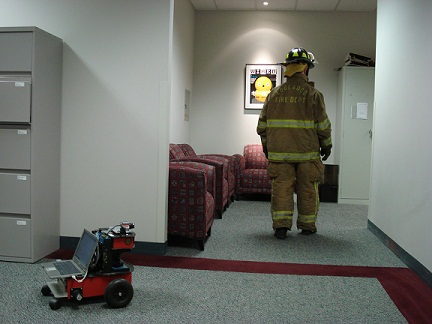 Image:Volunteer firefighter searching a building with a Pioneer robot. The robot provides localization information and situational awareness to the firefighter. Publications: G.
Hollinger, J. Djugash,
and S. Singh, "Target tracking without line of sight
using range from
radio," Autonomous
Robots (AURO), vol. 32, no. 1,
pp. 1-14,
Jan. 2012. Video.
G. Hollinger, J. Djugash, and S. Singh, "Tracking a moving target in cluttered environments with ranging radios," in Proc. IEEE International Conference on Robotics and Automation (ICRA), Pasadena, CA, May 2008, pp. 1430-1435. Video. G. Hollinger, J. Djugash, and S. Singh, "Coordinated search in cluttered environments using range from multiple robots," in Proc. International Conference on Field and Service Robotics (FSR), Chamonix, France, July 2007, pp. 433-442. Video. E. Liao, G. Hollinger, J. Djugash, and S. Singh, "Preliminary results in tracking mobile targets using range sensors from multiple robots," in Proc. International Symposium on Distributed Autonomous Robotic Systems (DARS), Minneapolis, MN, June 2006, pp. 125-134. |
| Personal
Robotics In
collaboration with Intel
Research Pittsburgh, I explored the interconnection between search and
action in the context of mobile robotics. The task of searching for an
object and then performing some action with that object is important in
many applications. Of particular interest is the idea of a
robot
assistant capable of performing worthwhile tasks around the home and
office (e.g., fetching coffee, washing dirty dishes, etc.).
I analyzed the search/action problem formally and proved that some tasks allow for search and action to be completely decoupled and solved separately, while other tasks require the problems to be analyzed together. In addition to theretical analysis, I designed a combined search/action approximation algorithm that draws on prior work in search. I showed the effectiveness of the algorithm by comparing it to state-of-the-art solvers, and I provided empirical evidence showing that search and action can be decoupled for some useful tasks. Finally, I demonstrated the approach on a Home Exploring Robot Butler (HERB) performing object search and delivery in an office environment. 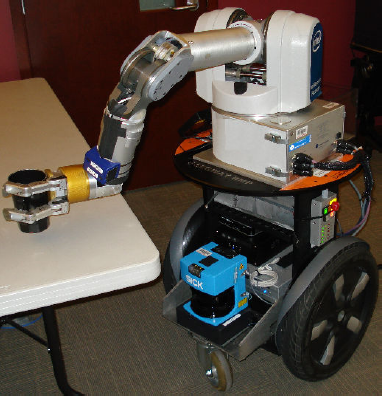  Images: The Home Exploring Robot Butler (HERB) locating a coffee mug and bringing it to the sink. The vehicle autonomously searches for the mug in a complex office environment. Publications: S. Srinivasa,
D. Ferguson, C. Helfrich, D. Berenson, A. Collet, R. Diankov, G.
Gallagher, G. Hollinger, J. Kuffner, and J.M. Vande Weghe, "Herb: A home exploring robotic butler," Autonomous Robots (AURO), vol. 28,
no. 1, pp. 5-20, Jan. 2010.
G. Hollinger, D. Ferguson, S. Srinivasa, and S. Singh, "Combining search and action for mobile robots," in Proc. IEEE International Conference on Robotics and Automation (ICRA), Kobe, Japan, May 2009, pp. 952-957. Video. |
| Aerial
Search and
Rescue My
undergraduate
thesis described the construction of a lighter-than-air
robotic
blimp for use in an urban search and rescue environment. The blimp uses
an onboard wireless camera, sonar, and infrared sensors to perform
tasks both autonomously and under teleoperated joystick control. During
autonomous flight, the blimp is capable of both following lines on the
floor and wandering without collision. Additionally, the blimp is
equipped with a marker deployment servo to allow the user to mark
victims that he or she has identified with the camera. The blimp uses a
modular software architecture with separate processes controlling
wireless communication, navigation, and vision. Ultimately, this design
shows the potential for the use of aerial robots in indoor search and
rescue environments.
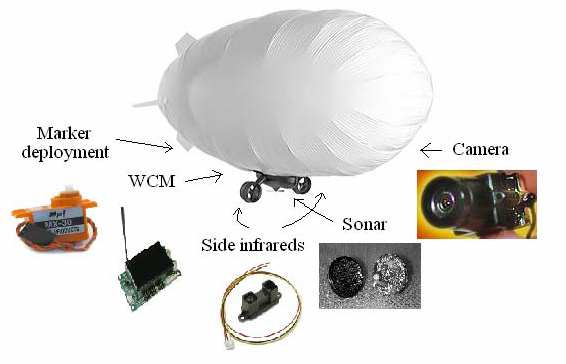 Image: Indoor robotic blimp designed for urban search and rescue tasks. Our blimp won the autonomy portion of the Drexel Aerial Robotics Competition (2005). Publications: G.
Hollinger,
Z. Pezzementi, and A. Flurie, "Design
and construction of an indoor robotic blimp for urban search and rescue
tasks," Senior design thesis,
Engineering Department, Swarthmore College, Swarthmore, PA, May 2005.
|
| Emotion-based
Social Robotics I
examined the problem of
buliding a robot that interacts with humans in a crowded conference
environment. The robot detects faces, determines the shirt color of
onlooking conference attendants, and reacts with a combination of
speech, musical, and movement responses. It continuously updates an
internal emotional state, modeled realistically after human psychology
research. Using empirically-determined mapping functions, the
robot’s state in the emotion space is translated to a
particular
set of sound and movement responses. I successfully demonstrated this
system at the AAAI ’05 Open Interaction Event, showing the
potential for emotional modeling to improve human-robot interaction.
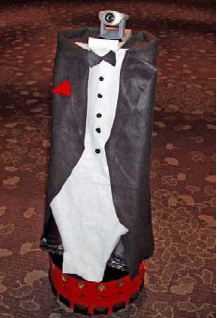 Image: Social mobile robot demonstrated at AAAI 2005. The robot uses emotion-based mechanisms to determine its actions and to better interact with onlookers. Publications: G. Hollinger,
Y. Georgiev, A. Manfredi, B. Maxwell, Z. Pezzementi, and B. Mitchell. "Design
of a social mobile robot using emotion-based decision mechanisms,"
in Proc. IEEE/RSJ International
Conference on Intelligent Robots and
Systems (IROS), Beijing, China, Oct. 2006, pp. 3093-3098.
|
| Miniature
Inspection Systems
Technology In
collaboration with
NASA's Marshall Space Flight Center, I
developed a miniature robot to inspect pipes both on Earth and in
zero-gravity. Using the
Darwin2k development software, a genetic
algorithm (GA) was employed to design and optimize a pipe-crawling
robot for parameters such as mass, power consumption, and joint
extension to further the research of the Miniature Inspection Systems
Technology (MIST) team. In an attempt to improve on existing designs, a
new robot was developed, the piezo robot. The final proposed design
uses piezoelectric expansion actuators to move the robot with a
‘chimneying’ method employed by mountain climbers
and
greatly improves on previous designs in load bearing ability, pipe
traversing specifications, and field usability.
In complementary work, I utilized a GA to design fault-tolerant analog controllers for the piezoelectric micro-robot. I developed first-order and second-order functions to model the robot’s piezoelectric actuators, and the GA was used to evolve closed-loop controllers for both models. Fault-tolerance was built into the fitness function to facilitate the design of controllers robust to both actuator failure and component failure. The GA was successfully used to design synthetic controllers and to optimize a traditional PID design. This research shows the advantages of GA assisted design when applied to robotic design and control problems. 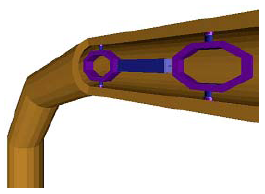 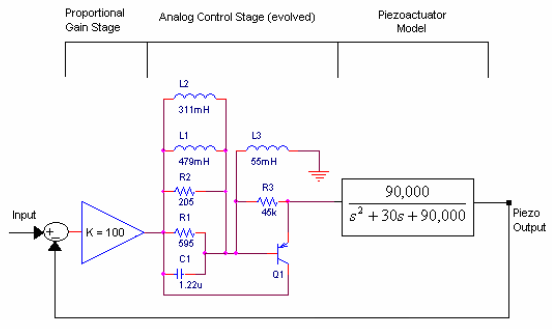 Images: Simulation of a piezoelectric pipe-crawling robot used to inspect pipes on the space shuttle (left). Fault-tolerant analog control designed using a genetic algorithm and utilized for the pipe-crawling robot (right). Publications: G.
Hollinger and D.
Gwaltney, "Evolutionary
design of fault-tolerant analog control for a piezoelectric
pipe-crawling robot," in Proc.
Genetic and Evolutionary
Computation Conference (GECCO),
Seattle, WA, July 2006, pp. 761-768.
G. Hollinger and J. Briscoe, "Genetic optimization and simulation of a piezoelectric pipe-crawling robot," in Proc. IEEE International Conference on Robotics and Automation (ICRA), Barcelona, Spain, Apr. 2005, pp. 484-489. Video 1, Video 2. |

Research
Geoffrey
A. Hollinger